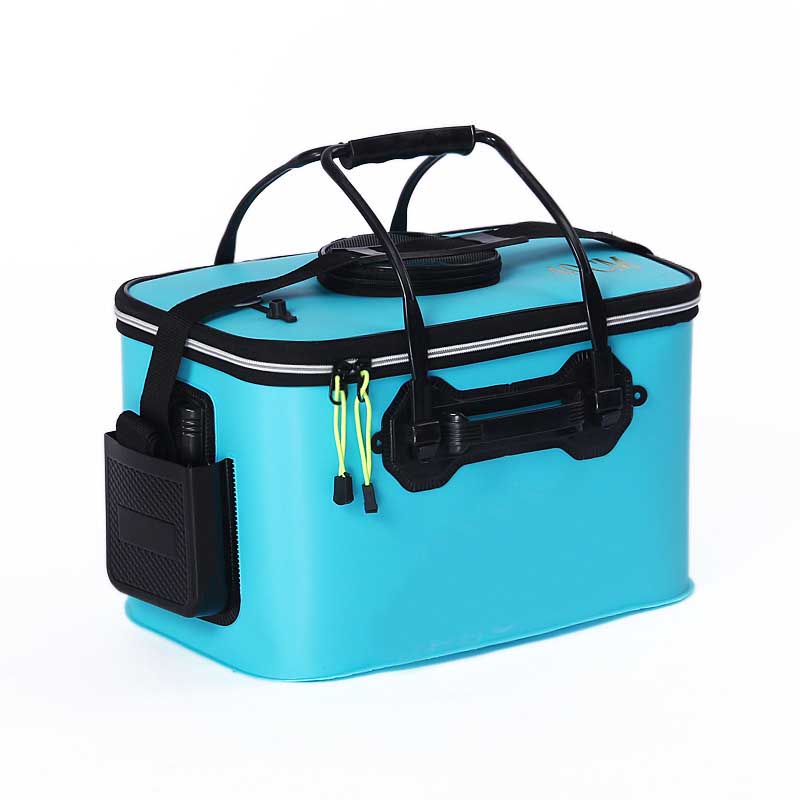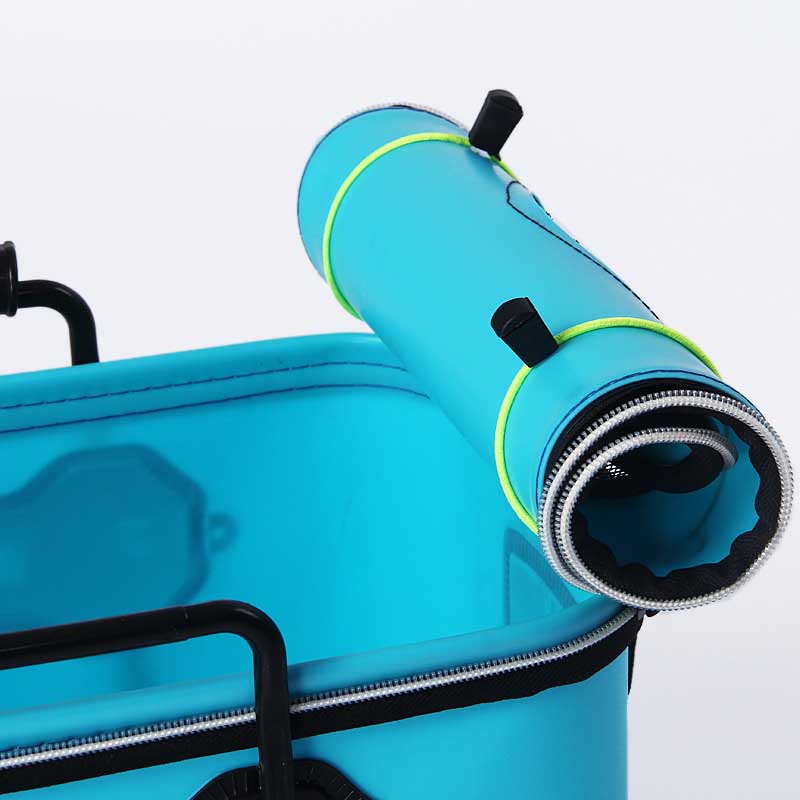While it might seem like just a simple container, I’ve found that a well-utilized ice fishing bucket is a game-changer on the frozen lake. The trick isn’t just in selecting the right bucket, but also in knowing how to make it serve multiple purposes.
I prefer a sturdy, insulated bucket that not only holds my gear but also keeps my catch cold and doubles as a seat when the action is slow. Inside, I organize my tackle, bait, and tools with precision, ensuring everything I need is within arm’s reach.
And when it comes to mobility, a bucket with a comfortable handle is invaluable as I move from hole to hole, chasing the bite. But there’s more to it than just storage and seating; in the following sections, I’ll share some lesser-known hacks that’ll turn your ice fishing bucket into your most versatile companion on the ice. ice fishing bucket

Key Takeaways Ice Fishing Bucket
- Prioritize durability and capacity when selecting an ice fishing bucket.
- Look for features like insulated liners, seat tops, and extra compartments to maximize efficiency and focus on the fishing experience.
- Keep your catch fresh by using insulation and packing snow around the fish in the bucket.
- Maintain your ice fishing bucket by cleaning it after each use, inspecting for cracks or holes, and storing it properly. Ice Fishing Bucket Ice Fishing Bucket
Selecting the Right Ice Fishing Buck

- When choosing an ice fishing bucket, prioritize durability and capacity to match your specific needs on the ice. I don’t mess around with flimsy gear that’ll crack at the first sign of a frostbite challenge. You need a bucket that’s tough as nails and can handle the weight of your catch, your gear, and if you’re like me, occasionally your backside when you use it as a makeshift seat.
- I recommend a ice fishing bucket that’s made from heavy-duty plastic or metal, with a capacity that won’t leave you wishing you’d brought a second one. Think about what you’re hauling – fish, equipment, maybe bait. You want a bucket that’s up to the task.ice fishing bucket
- Look for features like insulated liners to keep your catch fresh, a seat top for comfort, and extra compartments for tools. But don’t get seduced by unnecessary bells and whistles – simplicity often equates to reliability on the ice.
Essential Bucket Features
Having covered the importance of a sturdy, appropriately sized ice fishing bucket, let’s now focus on the must-have features that make a bucket indispensable on the ice.
When you’re braving the cold, the last thing you need is gear that can’t keep up. That’s why I look for:
- Insulation: A bucket that doubles as a cooler, keeping your catch fresh, is non-negotiable. I can’t afford to let my hard-earned fish spoil.
- Comfortable Seating: Hours on the ice can wreak havoc on my back. A padded lid that serves as a seat is a game-changer, offering me a bit of comfort in the harsh conditions.
- Storage Compartments: Efficiently using space means I can carry more tools and tackle. I opt for a bucket with built-in compartments, so I’m not wasting time digging around for what I need.
These features aren’t just about convenience; they’re about maximizing my time on the ice. I want to focus on the thrill of the catch, not on juggling inadequate equipment. So, I make sure my bucket’s working as hard as I am.ice fishing bucket
It’s not just a container—it’s my ice fishing command center.
Organizing Your Gear
To maximize my time on the ice, I meticulously organize my gear in the bucket’s compartments for easy access. Here’s how I do it:
First, I separate my gear by category. I keep all my jigs, lures, and baits in one section. I’ve got another for tools like pliers and scissors, and a special spot reserved for my line and hooks. It’s about being systematic – I know exactly where everything is.
I also prioritize what I’ll need most. The items I use frequently, I keep at the top or in the outer pockets. It’s all about efficiency; I can’t afford to waste time. I’m there to fish, not to search through a mess of gear.
Lastly, I make sure the bucket’s organized in a way that lets me move quickly. The real liberation comes from knowing I can set up, fish, and pack up without any hassle. It’s the freedom to focus on the experience, knowing I’ve got everything in its place.
That’s what it’s all about: simplicity and order, to better enjoy the thrill of the catch.
Comfortable Seating Solutions
I’ve discovered that a proper seat is crucial for staying comfortable during long hours on the ice. When you’re facing the biting cold and waiting patiently for a bite, the last thing you need is a sore backside.ice fishing bucket
I’ve tried a few options and found that the following work best:
- Cushioned Swivel Seat: This is a game-changer. By attaching a padded swivel seat to my bucket, I can twist and turn with ease, keeping an eye on all my lines without standing up. It’s a simple addition that offers comfort and mobility.
- Foam Pad Covers: If I’m looking for a quick and easy solution, I’ll grab a thick foam pad designed to fit over the bucket lid. It doesn’t get simpler than this – just pop it on, and you’ve got a cushion that makes a world of difference.
- Foldable Tripod Chair: Sometimes, I’ll bring along a compact tripod chair with a shoulder strap. It’s lightweight, portable, and I can set it right over the bucket when I need to access gear.
Using Buckets as Rod Holders
While ensuring comfort with the right seat is key, let’s not overlook the versatility of the bucket itself, especially as a makeshift rod holder when the fish are biting. I’ve found that with a little ingenuity, my trusty bucket can double as a sturdy stand for my rods, freeing up my hands and giving me the freedom to relax or attend to other tasks.
Here’s what I do: I simply cut notches into the lip of the bucket. These notches need to be wide enough to cradle the rod but snug enough to keep it secure. It’s a no-frills solution, but it works like a charm. When a fish takes the bait, I can quickly grab the rod and set the hook.
I also appreciate that using my bucket this way keeps my gear off the ice, preventing it from freezing over or getting tangled with others’. It’s a practical approach that maximizes my efficiency on the ice.
Keeping Your Catch Fresh
Once you’ve landed your catch, it’s crucial to keep it fresh until you’re ready to head home. Out on the ice, without the right know-how, your fish could spoil, and that’s the last thing I want after spending hours in the cold. Here’s how I ensure my fish stay in prime condition:
- Insulate with Snow: I pack snow around my fish in the bucket. Snow acts as a natural cooler, keeping the catch cold and preventing spoilage. Plus, it’s readily available out there on the ice.
- Minimize Air Exposure: I try to limit the time my fish spend out of the water. Once they’re out, I get them into the bucket and covered with snow as quickly as possible. Air dries out the fish, leading to a loss in flavor and texture.
- Use a Lining: If I’m planning to be out for a while, I’ll line my bucket with a plastic bag and add a layer of ice from the fishing hole. This makeshift cooler keeps things extra chilly.ice fishing bucket
I don’t mess around with freshness. By following these steps, I make sure every fish I proudly haul home is as fresh as when I pulled it from the icy depths. It’s all about respecting the catch and the effort it took to land it.
Transporting Your Equipment
Having secured the freshness of my catch, it’s time to focus on efficiently moving my gear across the ice. I’ve learned that simplifying my setup is key to maximizing my time fishing. I pack light, aiming to carry only what I’ll use. My ice fishing bucket isn’t just a cooler; it’s also my equipment carrier. I make sure it’s sturdy enough to handle the weight of my tackle, bait, tools, and snacks.
I’ll often attach a padded seat lid to my bucket, which serves a dual purpose—comfort during long waits, and it keeps my gear from spilling out during transport. I’ve customized my bucket with tool holders on the outside, so I can quickly grab what I need without rummaging through the inside.
For longer treks, I’ll hitch my bucket to a sled. This way, I’m not weighed down, and I can easily glide my equipment over the snow and ice. It’s about working smarter, not harder. I’m out here to enjoy the freedom of the ice, not to lug my gear back and forth. Every move I make is about keeping it light and simple, so I can freely chase the bite wherever it takes me.
Bucket Maintenance Tips
Regularly maintaining your ice fishing bucket ensures it remains reliable for each winter adventure. Here’s how I keep mine in top shape:
- Clean It Out After Each Use: I don’t let fish slime and bait residue turn into a funky science experiment. I scrub it down with soap and water, rinse it well, and then let it air dry before stowing it away. That way, it’s fresh and ready for the next trip.
- Inspect for Damage: Before and after I hit the ice, I give my bucket a once-over. Cracks or holes? I patch them up or consider replacing the bucket if it’s beyond a quick fix. I can’t risk water leakage or a bucket failure when I’m miles from shore.
- Store It Properly: I don’t just toss my bucket in the garage between seasons. I hang it up or place it on a shelf, ensuring it’s out of direct sunlight and away from sharp objects. This protects the material from degrading and keeps it from getting crushed or punctured.
Sticking to these tips means I’m never caught off guard with a busted bucket. It’s all about respecting the gear that keeps you fishing.ice fishing bucket
Ice Fishing Safety Precautions
While keeping my bucket in good shape is crucial, ensuring my own safety on the ice is even more critical. I’m keenly aware that the thrill of ice fishing comes with real risks, and I don’t take them lightly.
Before I even step foot on a frozen lake, I check the ice thickness. It’s gotta be at least four inches for walking, but I prefer a solid six for extra peace of mind.
I always tell someone where I’m going and when I plan to return. It’s not only smart; it’s a lifeline if things turn south. I’ve got my gear sorted too—spikes around my neck and a whistle within reach. If I break through, these tools are my immediate go-tos for self-rescue.
Dressing in layers is my mantra because hypothermia isn’t a joke. And I don’t just mean a thick jacket—I’m talking moisture-wicking base layers, insulation, and a waterproof shell. I keep moving to maintain warmth, but I’m careful not to break a sweat.
Lastly, I never fish alone. Having a buddy isn’t just for the laughs; it’s a safety net. We’ve both got each other’s backs, and that’s non-negotiable out here on the ice.
